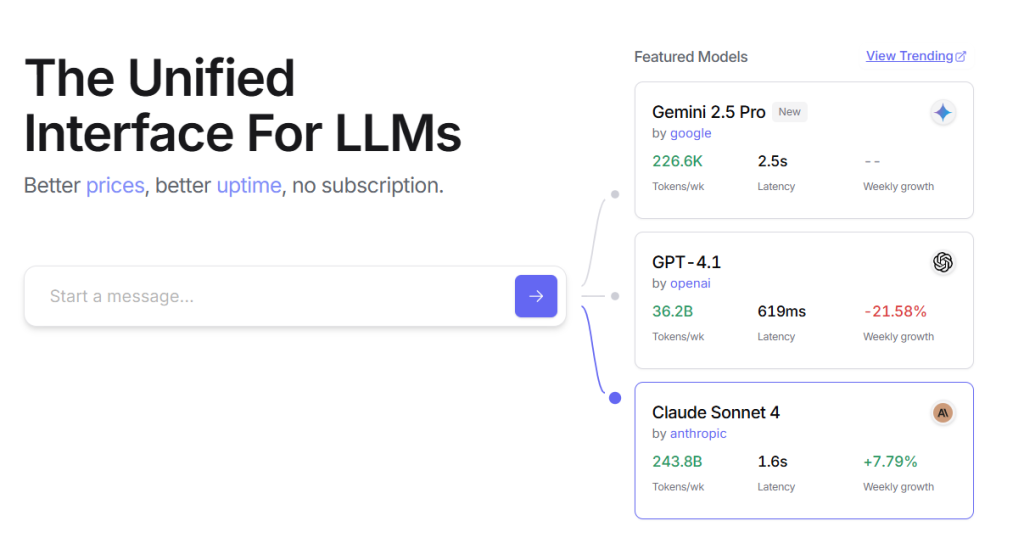From Hype to ROI: A short guide to selecting the right AI Model
The age of AI is not coming; it’s here. But for many, the initial excitement is giving way to a pressing question: how do we move from experimentation to actual return on investment? The answer doesn’t lie in simply adopting «an AI,» but in deploying the right AI for the right task. This requires a strategic shift from treating AI as a monolithic entity to viewing it as a portfolio of specialized tools. This is where the synergy of a powerful analysis platform and a versatile access gateway becomes a game-changer for your business.
What is the Challenge
We are inundated with options. Every week, it seems, a new, more powerful Large Language Model (LLM) is released, each with its own strengths, weaknesses, and, crucially, price point. For a business leader, this «paradox of choice» is a significant hurdle. Which model is best for drafting a detailed project proposal? Which is most cost-effective for summarizing daily reports? Which is fastest for real-time customer support?
As Frode Stenstrøm and myself explored in a recent project demonstration, a single workflow can have multiple, distinct AI needs. Imagine a project team at «Miljøpilotene,» a fictional environmental company. Their task is to create a project plan. This involves:
- Generating a Product Requirement Document (PRD): This requires a model with strong reasoning and writing capabilities.
- Creating a Gantt chart and a risk matrix: This might be better suited to a model adept at structured data generation.
- Drafting a presentation for stakeholders: This calls for a model that can synthesize information and present it clearly and concisely.
Using a single, top-of-the-line model for all these tasks is like using a sledgehammer to crack a nut. It’s inefficient, expensive, and unnecessary. The first part of the project demonstration can be found on YouTube here: AI for Prosjekt [del 1] ✨ Intro: AI’s rolle i prosjektarbeid 🗃️ (Sorry that it’s only available in Norwegian)
The Analysis
This is where a tool like Artificial Analysis ( https://artificialanalysis.ai/) becomes key. It is an independent AI benchmarking and analysis company that provides the data-driven insights needed to navigate the crowded AI landscape.
Artificial Analysis provides a clear, high-level view of the model ecosystem, breaking down the options by key business metrics:
- Intelligence and Performance: Through their «Artificial Analysis Intelligence Index,» they offer a synthesized score of a model’s capabilities across reasoning, knowledge, math, and programming. This allows for at-a-glance comparisons of overall model intelligence.
- Speed: They provide benchmarks on output tokens per second, a critical metric for any real-time or customer-facing application.
- Price: Perhaps most importantly, they offer clear, comparable pricing data, allowing you to make decisions that align with your budget and ROI goals.
By using Artificial Analysis, your technical leaders can move beyond marketing hype and make informed, data-driven decisions about which models to use for which tasks.

How about a Universal Translator
Once you’ve identified the best models for your needs, the next challenge is implementation. This is where OpenRouter ( https://openrouter.ai/) comes in. OpenRouter is a unified API gateway that acts as a «universal translator» for a vast array of AI models from different providers.
For your technical teams (like your CTO and developers), OpenRouter offers a number of significant advantages:
- Simplified Integration: Instead of building and maintaining separate integrations for each AI provider, your team can use a single, standardized API to access hundreds of models. This dramatically reduces development overhead and accelerates time-to-market.
- Unprecedented Flexibility: With OpenRouter, your applications can dynamically switch between models based on the specific task at hand. You can use a fast, inexpensive model for simple tasks and seamlessly switch to a more powerful model for complex requests, all within the same application.
- Reduced Vendor Lock-in: By abstracting the model layer, OpenRouter gives you the freedom to choose the best models for your needs, regardless of the provider. This future-proofs your AI strategy and prevents you from being locked into a single ecosystem.

The 1-2 Punch for Strategic AI Adoption
The synergy between Artificial Analysis and OpenRouter creates a powerful, two-step workflow for strategic AI adoption:
- Analyze (The «What»): Use Artificial Analysis to identify the optimal AI model for each specific business task, balancing performance, speed, and cost.
- Execute (The «How»): Use OpenRouter to seamlessly integrate and dynamically switch between your chosen models, ensuring that you’re always using the best tool for the job.
By adopting this approach, you can move beyond the AI hype and start building a truly intelligent, efficient, and cost-effective operation. The future of business isn’t about having AI; it’s about having an AI strategy. And with tools like Artificial Analysis and OpenRouter, you can ensure that your strategy is a winning one.
More about AI on my blog
Understanding the basics of AI: https://sjoholt.com/understanding-ai-a-non-technical-guide/
MCP Servers: https://sjoholt.com/mcp-servers-the-protocol-revolutionizing-ai-applications/